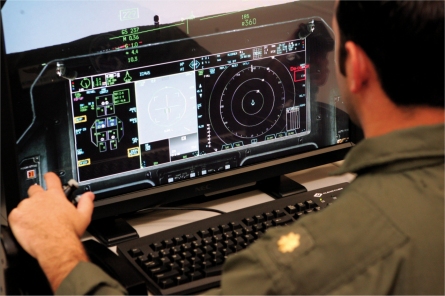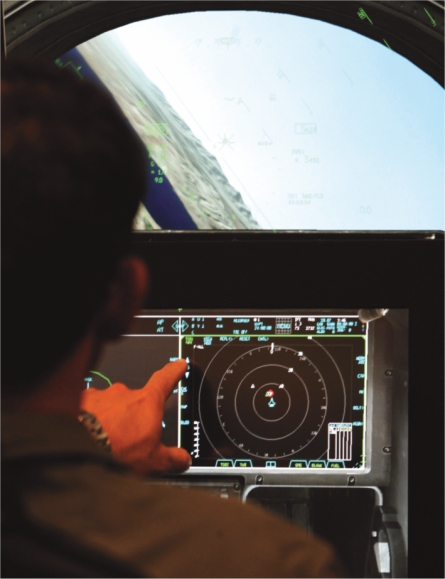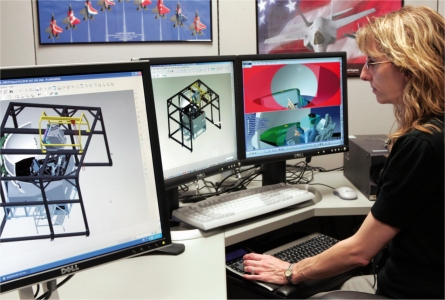Even as F-35 development aircraft begin moving down the final-assembly line at Lockheed Martin, preparations for training Joint Strike Fighter customer pilots are gathering pace.
The first production JSFs, two US Air Force conventional take-off and landing F-35As, are scheduled for delivery in 2010. They will be followed in 2011 by another six CTOL aircraft and the first six short take-off and vertical landing F-35Bs for the US Marine Corps.
The first F-35s for the US Navy and international JSF partners will follow soon after, and the JSF training system must be ready. The integrated training centre (ITC) at Eglin AFB in Florida, where training will be provided on all three variants for domestic and international customers, is planned to be up and running by 2011.
Training system development is on track, says programme manager JoAnne Puglisi. "We are where we said would be. We had a successful pilot training system critical design review in July and we are off cutting metal and writing code." The training syllabus for the initial Block 0.5-standard aircraft is close to being finalised, she says.
|
|---|
JSF training system development has been under way using prototype equipment |
PILOT DEVICE INTEGRATION
Lockheed is prime contractor for the training system as well as the aircraft, and within its Simulation, Training and Support business the Akron, Ohio plant is responsible for integrating the pilot training devices, with the first hardware already arriving from suppliers. Akron's previous experience includes full-mission simulators for the Boeing F-15 and Lockheed F-16.
Under its system development and demonstration (SDD) contract, Lockheed will produce "the first of everything", says Puglisi. This includes the first full-mission simulator, design of the deployable mission-rehearsal trainer (DMRT), the first set of courseware, computer-based training, student and lesson guides and the initial learning and training management systems.
SDD also includes design of the ITC at Eglin. The site activation task force has already stood up, but the need to complete an environmental impact statement has delayed work on the ITC, which will not be fully operational until 2015. As a result, an interim facility is to be established at Eglin to allow pilot training to begin by February 2010 for the CTOL F-35A and October 2010 for the STOVL F-35B.
An environmental impact statement is necessary because establishment of the F-35 ITC, ordered by the 2005 Base Realignment and Closure commission, will double the number of sorties at Eglin by the time the centre is fully operational. Local reports say Eglin plans to reduce the noise impact by spreading JSF flying training between three airfields at the base.
The ITC will be "the size of a Super Wal-Mart", says Puglisi, with 10 bays for full-mission simulators plus six maintenance training devices, classrooms and the training system support centre. "It will be very large," she says.
In contrast, the interim facility will be modest. As part of the first low-rate initial production (LRIP) lot of two aircraft, Lockheed plans to build a one-off mission rehearsal device for the facility. This will be a single fixed-based cockpit having a visual system with reduced field-of-view so it can fit inside an existing building at Elgin.
The production full-mission simulator will have a 360° dome visual display, while the DMRT will comprise two cockpits with smaller field-of-view visual displays installed side-by-side within a transportable Milvan container. SEOS is producing the visual displays while Rockwell Collins is supplying its EPX image generators.
The FMS has a 2m (6.5ft)-diameter dome surrounded by a frame mounting the liquid-crystal-on-silicon (LCoS) projectors. These project images onto the outside of the translucent acrylic dome - 23 image-generator channels and 25 projectors providing high brightness and resolution and eliminating the need for target projectors or target scaling, says display team lead Randy Wallace. The projectors have dual lamps for availability and reliability.
REDUCED HEIGHT
The dome is slightly "squashed" - reduced in height by 315mm - to save space, but is still compatible with the pilot's helmet-mounted display, the primary flight display on the F-35. "There is more movement of the head laterally versus vertically," says Wallace, explaining the unusual shape. As the pilot's head moves, areas of the dome that are not within view will be blackened out to reduce reflections and increase contrast, he says. A special algorithm will track head movement to provide "virtual collimation" of the projected image at the pilot's eyepoint.
Because of its size, the FMS needs a specially built facility. The cut-down mission-rehearsal device for the interim training facility, meanwhile, "will be okay for transitioning pilots" to the F-35, which will be the initial task at Eglin, Puglisi says. Once the full ITC is open, the device could be moved to another location for training. "There are a lot of possibilities," she says.
More devices will be added to the ITC with subsequent LRIP lots. "It will grow pretty quickly into a multi-service, multinational training centre," Puglisi says. JSF production plans remain fairly fluid, but the latest schedule calls for the UK to get its first two aircraft, and the Netherlands its first, in 2012. Italy is to get its first aircraft in 2013. These are all intended for operational testing in the USA.
Australia plans to begin purchasing aircraft in LRIP 5, with in-country deliveries beginning in 2014. On current plans, by the time the ITC is fully operational in 2015 five international partners will be receiving aircraft - a year later, all nine. And by then Israel could be the first foreign military sales customer.
This combination of three variants and 13 customers makes for a challenging training task. Commonality helps. Around 80% of the training syllabus will be made up of core tasks common at all variants and all customers. The remaining 20% will be unique to the service or the variant - but not necessarily both.
| |
|---|
The F-35 full-mission simulator has a dome display surrounded by structure and projectors |
COUNTRY-UNIQUE TRAINING
US Marine Corps and UK Royal Air Force and Royal Navy F-35B pilots, for example, will go through the common core syllabus then the STOVL syllabus, after which UK pilots will go on country-unique training. "The US Marine Corps and UK want to combine as much of their training as possible," says Puglisi.
There will be national differences between the customers' F-35s based on capability and releasability. While the software in the aircraft will be able to switch between the various versions depending on who is flying, this capability was too expensive for the training devices, she says, so the simulator software will be reloaded between sessions.
Flying and ground-based training will be integrated at the ITC, with a one-to-one ratio between flight and simulator events. "The simulator events will be a bit longer, because there is no fuel constraint, so there will be more hours in the simulator," she says. Simulation will also be brought into the classroom using desktop training aids.
Classroom training was demonstrated at the critical design review by rehosting theF-35's pilot-vehicle interface (PVI) development software on to Windows XP. This so-called "PVI XP" runs on a laptop.
"The instructor is able to teach the students the tactics and procedures for an intercept then push out a scenario to their laptops," says deputy programme manager Matt Robinson. Using the PVI XP along with a stick and throttle, the student can go through the scenario and be critiqued by the instructor and other students. "They can run through the procedure multiple times in the classroom before they go to the simulators," he says.
There will also be an embedded simulation capability in the aircraft, and the F-35 is to be compatible with the P5 rangeless air-to-air and air-to-ground combat training system. "We are defining the requirements and functionality and syncing it with the syllabus. Embedded training will complement what we do in the classroom," says Puglisi.
Instead of waiting until the aircraft is developed to get the flight software, the training team is receiving software drops as new versions are released by the air vehicle team. Puglisi says this is "a tremendous help in reducing risk".
 |
|---|
Desktop devices will allow pilots to practice |
Says Robinson: "We are reusing over 2 million lines of code out of the aircraft, rehosting it into the simulator." Around another million lines of code are being reused from other simulators, particularly in the instructor/operator system and brief/debrief system. "We have under a million lines of new code," he says.
Training at Eglin will begin with the Block 0.5 aircraft, the initial standard for mission-system capability. When the ITC opens in 2011 training is to switch to the more capable Block 1 aircraft. The final mission-system development standard, Block 3, is to be available at initial operational capability, which for the US Air Force F-35A is scheduled for 2013.
Elgin will be master training centre, but not the only one. Other "Tier 2" ITCs are planned in the USA and overseas, but only Eglin will host the training system support centre. With deliveries to most of the international customers expected to begin around 2014-15, Lockheed is already working with partner nations on their training requirements.
POOLING RESOURCES
"We need to find out which customers want a full ITC for pilot and maintenance training, and which customers only want maintenance training in-country and are prepared to share pilot training," says Puglisi. "We are getting requests and starting to talk to each of them, looking to see where we can pool resources and find locations."
The system architecture is modular, so that individual customers can have their own training centres if they desire. "It's scalable from four to 40 training devices, two to 20 classrooms, and six to 60 workstations," says Robinson.
Lockheed is already under contract within the SDD phase to complete the preliminary design of an ITC for the UK, says Robinson. Preliminary pilot training throughput and facility sizing studies are under way for Australia and Canada, while Turkey has expressed interest in hosting a maintenance training centre. "Most of the countries want a national maintenance training capability. It is more cost-effective because it avoids the travel costs," he says.
Development of the maintenance training system is running behind that for pilot training because of the air vehicle redesign in 2001 to reduce the weight of the STOVL F-35. "The design changed and that impacted system locations, so we moved the maintenance training system CDR to December 2008," she says.
KEEPING UP WITH CHANGE
Where hands-on hardware trainers will be used, principally to teach ejection-seat pyrotechnics maintenance and weapons loading, these devices needed to represent the revised aircraft design. The team also needed updated information on system reliability as that drives the tasks for which the maintainers must be trained.
Lockheed plans to buy the maintenance trainers for the ITC at the end of 2010. UK company EDM is already under contract and is building the first ejection-seat and weapons-loading hardware trainers under the SDD programme. The handful of competitions that remain to complete the selection of F-35 training system suppliers, such as desktop virtual diagnostic trainers, are planned for early 2008.
The overall JSF programme still faces schedule and funding challenges, although Lockheed says the first F-35B is on track to fly in May 2008. US Congress has fully funded LRIP 2 procurement of 12 F-35s in fiscal year 2008, although the impact of a cut in development funding is not yet known. But thegoal for the JSF training system team remains to be ready ahead of delivery of this first aircraft in 2010.
 |
|---|
Lockheed has rehosted the F-35 pilot-vehicle interface software on to a Windows XP platform |
Source: Flight International


















